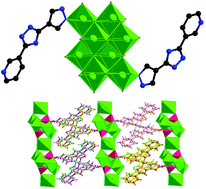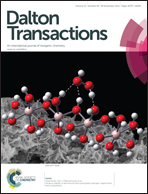A polyoxometalate-based complex with visible-light photochromism as the electrocatalyst for generating hydrogen from water†
Abstract
Two polyoxometalate (POM)-based complexes formulated as (HL1)2(Mo8O26)·2HL1·11H2O (L1 = 3-(5-(1H-pyrazol-4-yl)-1H-1,2,4-triazol-3-yl)pyridine) (1) and Co2(L2)4[P2MoVI5O23MoII(H2O)2]·3H2O (L2 = 4-(5-(2H-1,2,4-triazol-3-yl)-2H-1,2,4-triazol-3-yl)pyridine) (2) have been synthesized and structurally characterized by single-crystal X-ray diffraction. Complex 1 shows a bi-capped POM with the two Mo centers from the [Mo8O26]4− moiety coordinated by two HL1 ligands via two Mo–N bonds. Complex 2 consists of a mononuclear unsaturated coordinated Co(II) unit and a [P2MoVI5O23MoII(H2O)2]4− moiety, in which [P2MoVI5O23MoII(H2O)2]4− shows a chain-like structure constructed from edge-sharing or vertex-sharing {MoO6} and {PO4} polyhedra. The two complexes are both soluble in neutral aqueous solution and they can electrocatalyze the H2 evolution reaction (HER) from water with lowered overpotentials and enhanced currents, and complex 1 shows better electrocatalytic activity for the HER than complex 2. Complex 1 shows visible-light photochromism. In the presence of complex 1, the HER current is enhanced with visible-light irradiation in comparison with the current without light irradiation.


 Please wait while we load your content...
Please wait while we load your content...